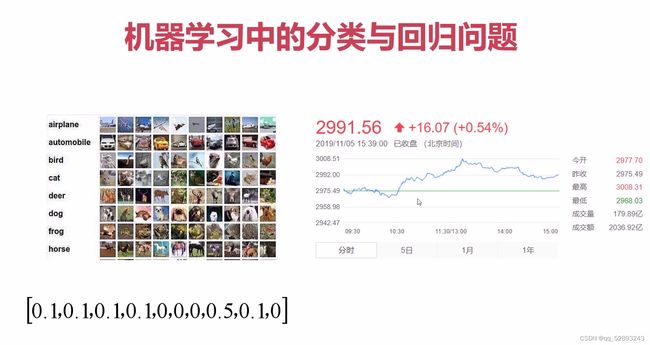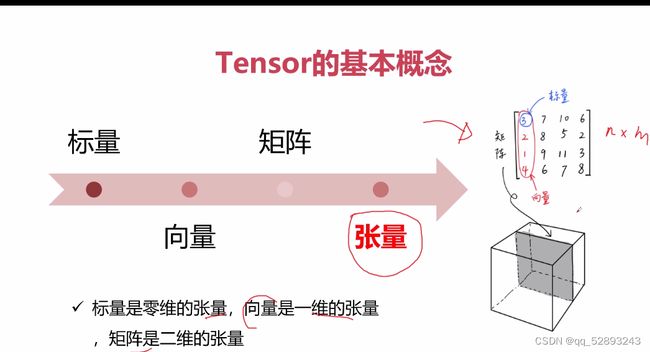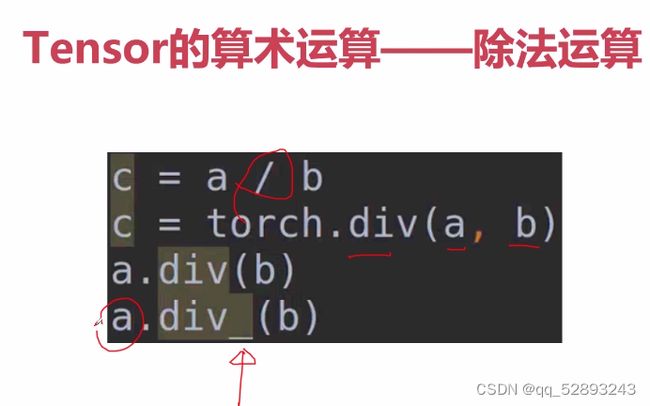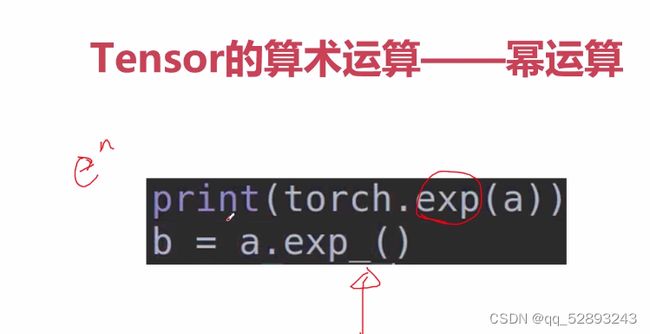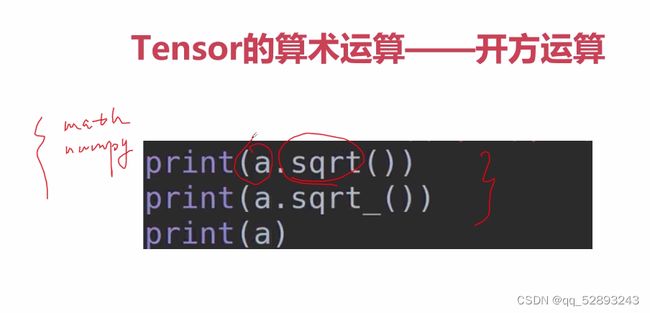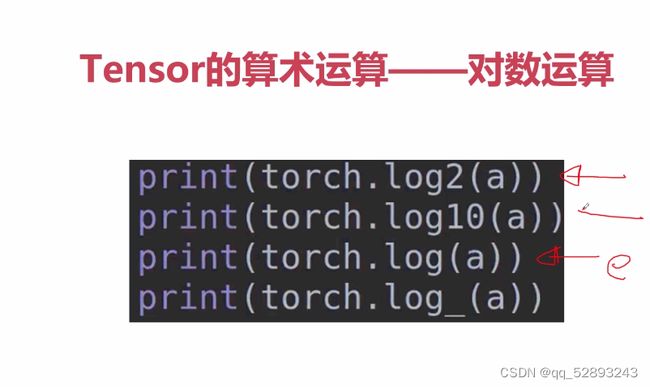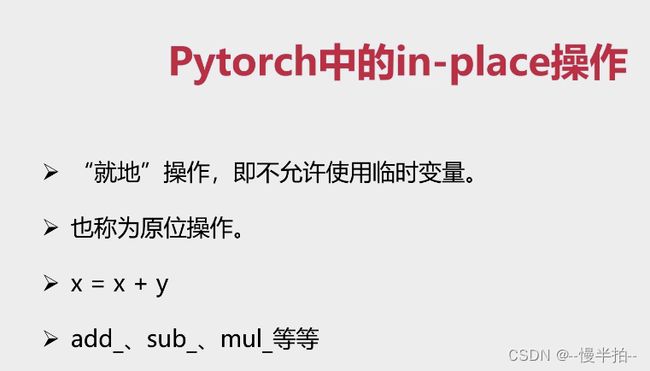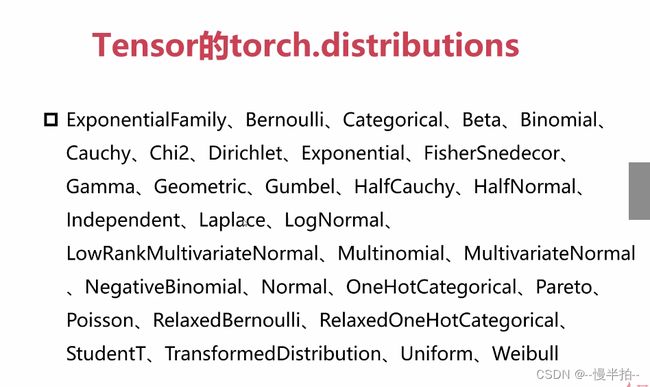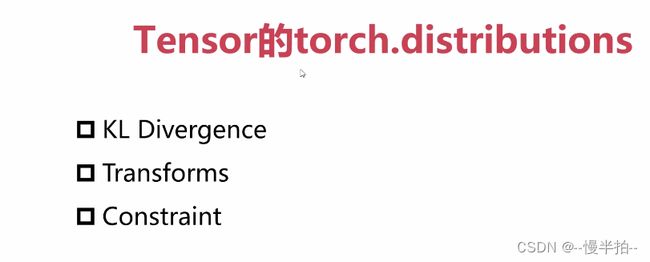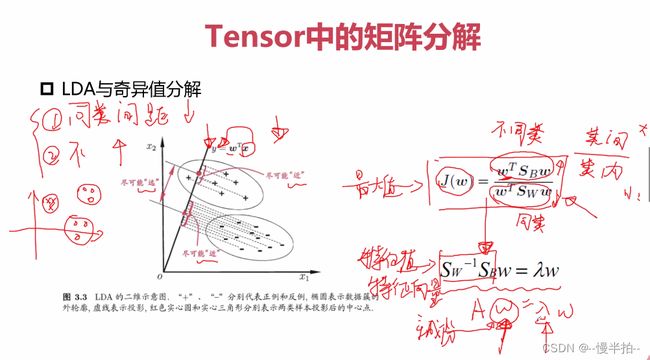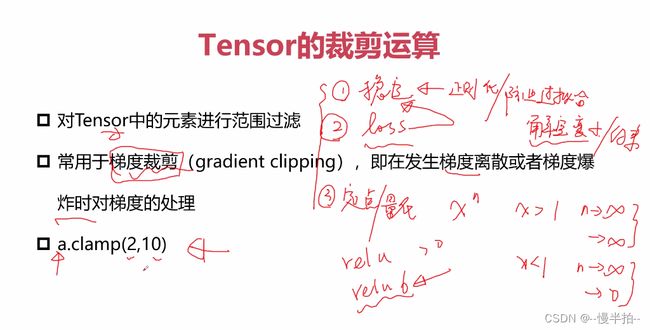pytorch基础操作
文章目录
-
- 1 机器学习基本构成元素
- 2 pytorch基本概念
- 3 tensor与机器学习的关系
- 4 tensor创建编程实例
- 5 tensor的属性
- 6 稀疏张量的编程实践
- 7 tensor的算数运算
- 8 tensor算术运算编程实例
- 9 in-place的概念和广播机制
- 10 取整-余
- 11 比较运算-排序
- 12 三角函数
- 13 其他数学函数
- 14 pytorch与统计学方法
- 15 pytorch与分布函数
- 16 pytorch与随机抽样
- 17 pytorch与线性代数
- 18 pytorch与矩阵分解-PCA
- 19 SVD分解-LDA
- 20 pytorch与张量裁剪
- 21 张量的索引与数据筛选
- 22 张量组合与拼接
1 机器学习基本构成元素
2 pytorch基本概念
3 tensor与机器学习的关系
4 tensor创建编程实例
import torch
a = torch.Tensor([[1,2],[3,4]])
print(a)
print(a.type())
a=torch.Tensor(2,3)
print(a)
print(a.type())
'''几种特殊的tensor'''
a=torch.ones(2,2)
print(a)
print(a.type())
a=torch.eye(2,2)
print(a)
print(a.type())
a=torch.zeros(2,2)
print(a)
print(a.type())
b = torch.Tensor(2,3)
b = torch.ones_like(b)
b = torch.zeros_like(b)
print(b)
print(b.type())
'''随机'''
a= torch.rand(2,2)
print(a)
print(a.type())
a = torch.normal(mean=0.0, std=torch.rand(5)) #正态分布
print(a)
print(a.type())
a = torch.normal(mean=torch.rand(5), std=torch.rand(5)) #正态分布
print(a)
print(a.type())
'''a = torch.Tensor(2,2).uniform(-1,1) #均匀分布要指定Tensor的大小
print(a)
print(a.type())'''
a = torch.arange(0,10,1)
print(a)
print(a.type())
a = torch.linspace(2,10,4) #拿到等间隔的n个数字
print(a)
print(a.type())
a = torch.randperm(10)
print(a)
print(a.type())
################
import numpy as np
a = np.array([[1,2],[3,4]])
print(a)
b = np.eye(3)
print(b)
5 tensor的属性
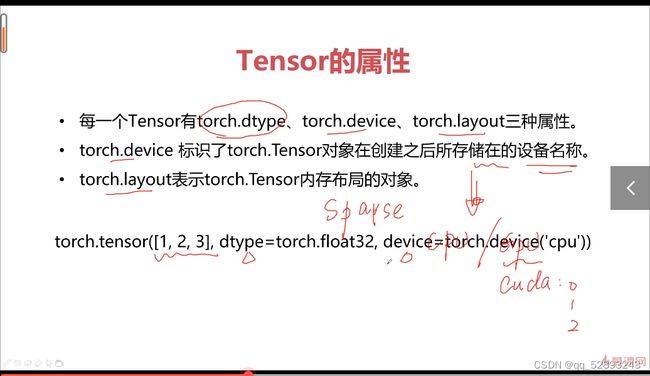

稀疏(零元素的个数越多越稀疏)
①稀疏使模型更简单
②减少内存的开销
6 稀疏张量的编程实践
import torch
dev = torch.device("cpu")
dev = torch.device("cuda")
a = torch.tensor([2,2],dtype=torch.float32,device=dev)
print(a)
i = torch.tensor([[0,1,2],[0,1,2]])
v = torch.tensor([1,2,3])
a= torch.sparse_coo_tensor(i,v,(4,4))
print(a) #稀疏的张量
i = torch.tensor([[0,1,2],[0,1,2]])
v = torch.tensor([1,2,3])
a= torch.sparse_coo_tensor(i,v,(4,4),
dtype=torch.float32,
device=dev).to_dense() #device是对资源的分配cpu,gpu
print(a) # 转换成稠密的张量
7 tensor的算数运算
8 tensor算术运算编程实例
import torch
#add
a=torch.rand(2,3)
b=torch.rand(2,3)
print(a)
print(b)
print(a+b)
print(a.add(b))
print(torch.add(a,b))
print(a)
print(a.add_(b))
print(a)
#sub
print("==== sub ====")
print(a-b)
print(a.sub(b))
print(torch.sub(a,b))
print(a)
print(a.sub_(b))
print(a)
#mul
print("==== mul ====")
print(a*b)
print(a.mul(b))
print(torch.mul(a,b))
print(a)
print(a.mul_(b))
print(a)
print("==== div ====")
print(a/b)
print(a.div(b))
print(torch.div(a,b))
print(a.div_(b))
print(a)
###matmul
a = torch.ones(2,1)
b = torch.ones(1,2)
print(a @ b)
print(a.matmul(b))
print(torch.matmul(a,b))
print(torch.mm(a,b))
print(a.mm(b))
###高维tensor
a = torch.ones(1,2,3,4)
b = torch.ones(1,2,4,3)
print(a.matmul(b).shape)
##pow
a = torch.tensor([1,2])
print(a)
print(torch.pow(a,3))
print(a.pow(3))
print(a**3)
print(a.pow_(3))
print(a)
#exp
a = torch.tensor([1,2],dtype=torch.float32)
print(torch.exp(a))
print(torch.exp_(a))
print(a.exp())
print(a.exp_())
###log
a = torch.tensor([10,2],dtype=torch.float32)
print(torch.log(a))
print(torch.log_(a))
print(a.log())
print(a.log_())
###sqrt
a = torch.tensor([10,2],dtype=torch.float32)
print(torch.sqrt(a))
print(torch.sqrt_(a))
print(a.sqrt())
print(a.sqrt_())
9 in-place的概念和广播机制
import torch
a = torch.rand(2,1,1,3)
b = torch.rand(4,2,3)
# a, 2*1
# b, 1*2
# c, 2*2
# c, 2*4*2*3
c = a+b
print(a)
print(b)
print(c)
print(c.shape)
10 取整-余
11 比较运算-排序
import torch
a = torch.rand(2,3)
b = torch.rand(2,3)
print(a)
print(b)
print(torch.eq(a,b)) #等于
print(torch.equal(a,b))
print(torch.ge(a,b)) #大于等于
print(torch.gt(a,b)) #大于
print(torch.le(a,b)) #小于等于
print(torch.lt(a,b)) #小于
print(torch.ne(a,b)) #不等于
####
a = torch.tensor([1,4,4,3,5])
print(torch.sort(a))
print(torch.sort(a,descending=True))
b = torch.tensor([[1,4,4,3,5],
[2,3,1,3,5]])
print(b.shape)
print(torch.sort(b,dim=1,descending=False)) #dim=0对2这个维度排序,dim=1对5这个维度排序
#####topk
a= torch.tensor([[2,4,3,1,5],
[2,3,5,1,4]])
print(a.shape)
print(torch.topk(a,k=2,dim=1))
print(torch.topk(a,k=1,dim=0))
print(torch.kthvalue(a,k=2,dim=0))
print(torch.kthvalue(a,k=2,dim=1)) #取第二小的数
a = torch.rand(2,3)
print(a)
print(a/0)
print(torch.isfinite(a)) #看看是否有界
print(torch.isfinite(a/0))
print(torch.isinf(a/0)) #看看是否无界
print(torch.isnan(a))
import numpy as np
b = torch.tensor([1,2,np.nan])
print(torch.isnan(b))
12 三角函数
import torch
a = torch.zeros(2,3)
b = torch.cos(a)
print(a)
print(b)
13 其他数学函数
14 pytorch与统计学方法
import torch
a = torch.rand(2,2)
print(a)
print(torch.mean(a))
print(torch.sum(a))
print(torch.prod(a))
b = torch.rand(2,2)
print(b)
print(torch.mean(b,dim=0))
print(torch.sum(b,dim=0))
print(torch.prod(b,dim=0))
print(torch.argmax(a,dim=0))
print(torch.argmin(a,dim=0))
print(torch.std(a)) #标准差
print(torch.var(a)) #方差
print(torch.median(a)) #中值
print(torch.mode(a)) #众数
a = torch.rand(2,2)*10
print(a)
print(torch.histc(a,6,0,0))
a= torch.randint(0,10,[10])
print(a)
print(torch.bincount(a)) #bincount只能处理1维的
#统计某一类别样本的个数
15 pytorch与分布函数
16 pytorch与随机抽样
import torch
torch.manual_seed(1)
mean = torch.rand(1,2)
std = torch.rand(1,2)
print(torch.normal(mean,std)) #正态分布
17 pytorch与线性代数

0范数是指向量中非零元素的个数
1范数是指元素的绝对值的和
通过范数约束可以完成对模型参数的约束
18 pytorch与矩阵分解-PCA
矩阵分解:解决和分析最优化问题时会用到

LU、QR用的不多
EVD、SVD用的较多,需要掌握。与EVD分解相对应的是PCA算法(无监督的算法),与SVD分解相对应的是LDA算法(可以完成特征工程的降维,引入了学习的因素,有监督的算法)。
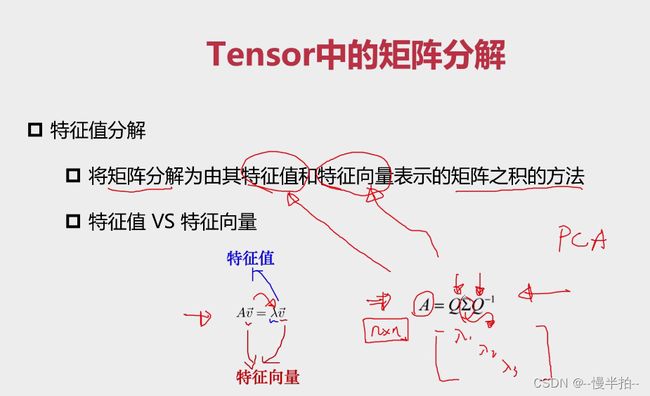
满秩的矩阵称为奇异矩阵(用EVD),不满秩的矩阵称为非奇异矩阵(用SVD)。

方差越大,说明特征值越丰富,相关性越低,信息之间的冗余度越低
把n维中能量低的去掉,保留其中k维能量高的。
19 SVD分解-LDA
SB是同类物体之间的协方差矩阵
Sw是不同类物体之间的协方差矩阵
类内要小,类间要大
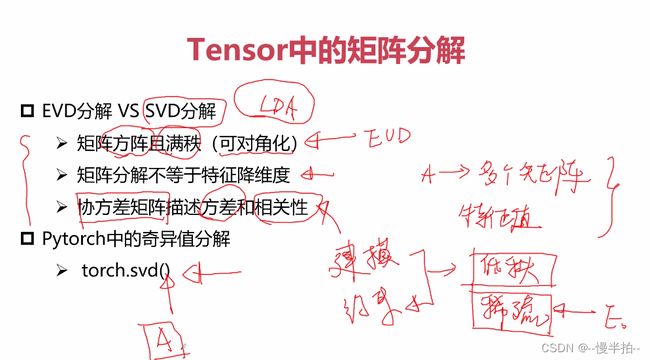
20 pytorch与张量裁剪
import torch
a = torch.rand(2,2)*10
print(a)
a = a.clamp(2,5)
print(a)
21 张量的索引与数据筛选
import torch
#torch.where
a = torch.rand(4,4)
b = torch.rand(4,4)
print(a)
print(b)
out = torch.where(a>0.5,a,b)#大于0.5输出a,否则输出b
print(out)
'''
tensor([[0.4527, 0.6981, 0.1994, 0.2436],
[0.7594, 0.1886, 0.5046, 0.9406],
[0.9217, 0.2026, 0.1484, 0.1788],
[0.8292, 0.4543, 0.4000, 0.3469]])
tensor([[0.1317, 0.3827, 0.8856, 0.8149],
[0.1946, 0.1278, 0.1825, 0.3817],
[0.7441, 0.5222, 0.3295, 0.4972],
[0.3863, 0.8676, 0.9039, 0.1099]])
tensor([[0.1317, 0.6981, 0.8856, 0.8149],
[0.7594, 0.1278, 0.5046, 0.9406],
[0.9217, 0.5222, 0.3295, 0.4972],
[0.8292, 0.8676, 0.9039, 0.1099]])
'''
#torch.index_select
a = torch.rand(4,4)
print(a)
out = torch.index_select(a,dim=0,
index=torch.tensor([0,3,2]))#取a的第0,3,2行进行输出
print(out)
'''
tensor([[0.1697, 0.1639, 0.6349, 0.1004],
[0.2946, 0.5318, 0.9958, 0.1493],
[0.3166, 0.2766, 0.5476, 0.7023],
[0.5456, 0.4693, 0.3431, 0.0805]])
tensor([[0.1697, 0.1639, 0.6349, 0.1004],
[0.5456, 0.4693, 0.3431, 0.0805],
[0.3166, 0.2766, 0.5476, 0.7023]])
'''
#torch.gather
a = torch.linspace(1,16,16).view(4,4)
print(a)
out = torch.gather(a,dim=0,
index=torch.tensor([[0,1,1,1],
[0,1,2,2],
[0,1,3,3]]))
print(out)
'''
tensor([[ 1., 2., 3., 4.],
[ 5., 6., 7., 8.],
[ 9., 10., 11., 12.],
[13., 14., 15., 16.]])
tensor([[ 1., 6., 7., 8.],
[ 1., 6., 11., 12.],
[ 1., 6., 15., 16.]])
'''
#torch.masked_index
a = torch.linspace(1,16,16).view(4,4)
mask = torch.gt(a,8)
print(a)
print(mask)
out = torch.masked_select(a,mask)
print(out)
'''
tensor([[ 1., 2., 3., 4.],
[ 5., 6., 7., 8.],
[ 9., 10., 11., 12.],
[13., 14., 15., 16.]])
tensor([[False, False, False, False],
[False, False, False, False],
[ True, True, True, True],
[ True, True, True, True]])
tensor([ 9., 10., 11., 12., 13., 14., 15., 16.])
'''
#torch.take
a = torch.linspace(1,16,16).view(4,4)
b = torch.take(a,index=torch.tensor([0,15,13,10]))
print(b)
'''
tensor([ 1., 16., 14., 11.])
'''
#torch.nonzero
a = torch.tensor([[0,1,2,0],[2,3,0,1]])
out = torch.nonzero(a)
print(out)#稀疏表示
'''
tensor([[0, 1],
[0, 2],
[1, 0],
[1, 1],
[1, 3]])
'''
22 张量组合与拼接
import torch
a = torch.zeros((2,4))
b = torch.ones((2,4))
out = torch.cat((a,b),dim=0)
print(out)
'''
tensor([[0., 0., 0., 0.],
[0., 0., 0., 0.],
[1., 1., 1., 1.],
[1., 1., 1., 1.]])
'''
out = torch.cat((a,b),dim=1)
print(out)
'''
tensor([[0., 0., 0., 0., 1., 1., 1., 1.],
[0., 0., 0., 0., 1., 1., 1., 1.]])
'''
#torch.stack
a = torch.linspace(1,6,6).view(2,3)
b = torch.linspace(7,12,6).view(2,3)
out = torch.stack((a,b),dim=0)
print(out)
print(out.shape)
'''
tensor([[[ 1., 2., 3.],
[ 4., 5., 6.]],
[[ 7., 8., 9.],
[10., 11., 12.]]])
torch.Size([2, 2, 3])
'''
out = torch.stack((a,b),dim=1)
print(out)
print(out.shape)
'''
tensor([[[ 1., 2., 3.],
[ 7., 8., 9.]],
[[ 4., 5., 6.],
[10., 11., 12.]]])
torch.Size([2, 2, 3])
'''
out = torch.stack((a,b),dim=2)
print(out)
print(out.shape)
'''
tensor([[[ 1., 7.],
[ 2., 8.],
[ 3., 9.]],
[[ 4., 10.],
[ 5., 11.],
[ 6., 12.]]])
torch.Size([2, 3, 2])
'''
在深度学习当中cat用的比较多
